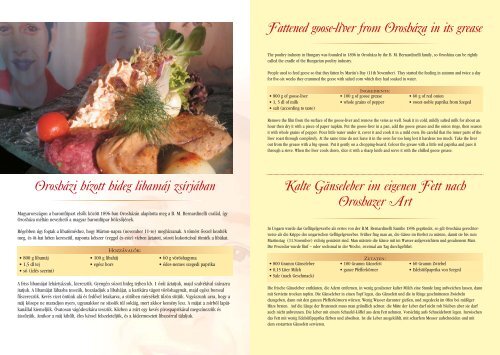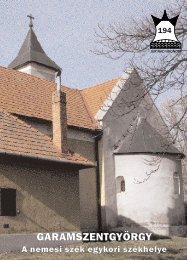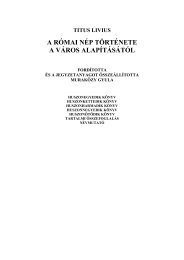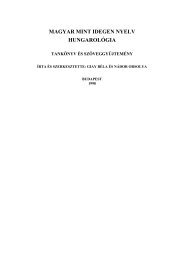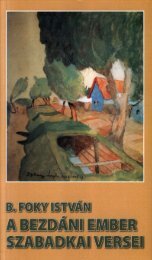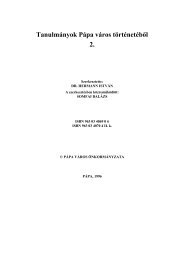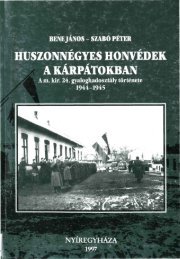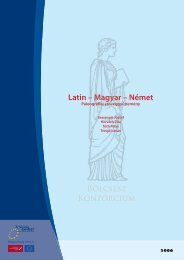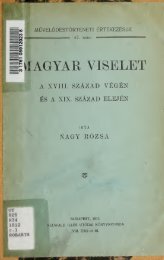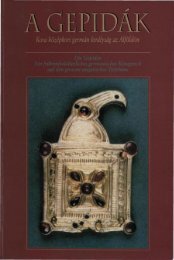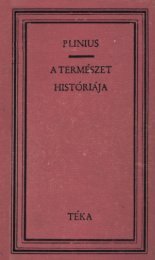RECEPTKÖNYV • RECIPE BOOK • REZEPT BUCH
RECEPTKÖNYV • RECIPE BOOK • REZEPT BUCH
RECEPTKÖNYV • RECIPE BOOK • REZEPT BUCH
Sie wollen auch ein ePaper? Erhöhen Sie die Reichweite Ihrer Titel.
YUMPU macht aus Druck-PDFs automatisch weboptimierte ePaper, die Google liebt.
Fattened goose-liver from Orosháza in its grease<br />
The poultry industry in Hungary was founded in 1896 in Orosháza by the B. M. Bernardinelli family, so Orosháza can be rightly<br />
called the cradle of the Hungarian poultry industry.<br />
People used to feed geese so that they fatten by Martin’s Day (11th November). They started the feeding in autumn and twice a day<br />
for five-six weeks they crammed the geese with salted corn which they had soaked in water.<br />
Ingredients:<br />
<strong>•</strong> 800 g of goose-liver <strong>•</strong> 100 g of goose grease <strong>•</strong> 60 g of red onion<br />
<strong>•</strong> 1, 5 dl of milk <strong>•</strong> whole grains of pepper <strong>•</strong> sweet-noble paprika from Szeged<br />
<strong>•</strong> salt (according to taste)<br />
Remove the film from the surface of the goose-liver and remove the veins as well. Soak it in cold, mildly salted milk for about an<br />
hour then dry it with a piece of paper napkin. Put the goose-liver in a pan, add the goose grease and the onion rings, then season<br />
it with whole grains of pepper. Pour little water under it, cover it and cook it in a mild oven. Be careful that the inner parts of the<br />
liver roast through completely. At the same time do not leave it in the oven for too long lest it hardens too much. Take the liver<br />
out from the grease with a big spoon. Put it gently on a chopping-board. Colour the grease with a little red paprika and pass it<br />
through a sieve. When the liver cools down, slice it with a sharp knife and serve it with the chilled goose grease.<br />
Orosházi hízott hideg libamáj zsírjában<br />
Magyarországon a baromfiipart elsôk között 1896-ban Orosházán alapította meg a B. M. Bernardinelli család, így<br />
Orosháza méltán nevezhetô a magyar baromfiipar bölcsôjének.<br />
Régebben úgy fogtak a libatöméshez, hogy Márton-napra (november 11-re) meghízzanak. A tömést ôsszel kezdték<br />
meg, és öt-hat héten keresztül, naponta kétszer (reggel és este) vízben áztatott, sózott kukoricával tömték a libákat.<br />
Hozzávalók:<br />
<strong>•</strong> 800 g libamáj <strong>•</strong> 100 g libaháj <strong>•</strong> 60 g vöröshagyma<br />
<strong>•</strong> 1,5 dl tej <strong>•</strong> egész bors <strong>•</strong> édes-nemes szegedi paprika<br />
<strong>•</strong> só (ízlés szerint)<br />
A friss libamájat lehártyázzuk, kierezzük. Gyengén sózott hideg tejben kb. 1 órát áztatjuk, majd szalvétával szárazra<br />
itatjuk. A libamájat lábasba tesszük, hozzáadjuk a libahájat, a karikára vágott vöröshagymát, majd egész borssal<br />
fûszerezzük. Kevés vizet öntünk alá és fedôvel letakarva, a sütôben mérsékelt tûzön sütjük. Vigyázzunk arra, hogy a<br />
máj közepe ne maradjon nyers, ugyanakkor ne süssük túl sokáig, mert akkor kemény lesz. A májat a zsírból lapátkanállal<br />
kiemeljük. Óvatosan vágódeszkára tesszük. Közben a zsírt egy kevés pirospaprikával megszínezzük és<br />
átszûrjük. Amikor a máj kihûlt, éles késsel felszeleteljük, és a kidermesztett libazsírral tálaljuk.<br />
Kalte Gänseleber im eigenen Fett nach<br />
Oroshazer Art<br />
In Ungarn wurde das Geflügelgewerbe als erstes von der B.M. Bernardinelli Familie 1896 gegründet, so gilt Orosháza gerechterweise<br />
als die Krippe des ungarischen Geflügelgewerbes. Früher fing man an, die Gänse im Herbst zu mästen, damit sie bis zum<br />
Martinstag (11.November) richrig gemästet sind. Man mästete die Gänse mit im Wasser aufgeweichtem und gesalzenem Mais.<br />
Die Prozedur wurde fünf – oder sechsmal in der Woche, zweimal am Tag durchgeführt.<br />
Zutaten:<br />
<strong>•</strong> 800 Gramm Gänseleber <strong>•</strong> 100 Gramm Gänsefett <strong>•</strong> 60 Gramm Zwiebel<br />
<strong>•</strong> 0,15 Liter Milch <strong>•</strong> ganze Pfefferkörner <strong>•</strong> Edelsüßpaprika von Szeged<br />
<strong>•</strong> Salz (nach Geschmack)<br />
Die frische Gänseleber enthäuten, die Adern entfernen, in wenig gesalzener kalter Milch eine Stunde lang aufweichen lassen, dann<br />
mit Serviette trocken tupfen. Die Gänseleber in einen Topf legen, das Gänsefett und die in Ringe geschnittenen Zwiebeln<br />
dazugeben, dann mit den ganzen Pfefferkörnern würzen. Wenig Wasser darunter gießen, und zugedeckt im Ofen bei mäßiger<br />
Hitze braten. Auf die Länge der Bratenzeit muss man gründlich achten: die Mitte der Leber darf nicht roh bleiben aber sie darf<br />
auch nicht anbrennen. Die Leber mit einem Schaufel-Löffel aus dem Fett nehmen. Vorsichtig aufs Schneidebrett legen. Inzwischen<br />
das Fett mit wenig Edelsüßpaprika färben und abseihen. Ist die Leber ausgekühlt, mit scharfem Messer aufschneiden und mit<br />
dem erstarrten Gänsefett servieren.


